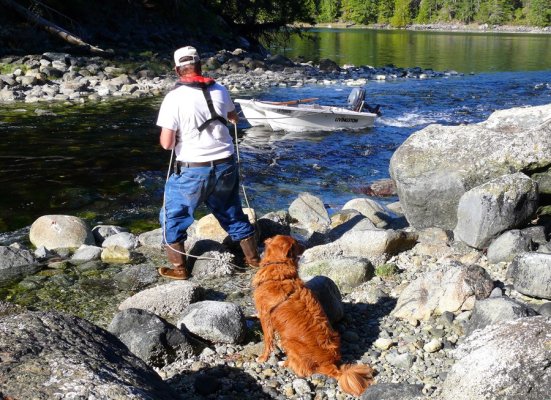Back in 1977 I shipped my Land Rover from Honolulu to Oakland, California (and back) for a six week campling/fishing/canoeing trip to the Yukon Territory with a good friend* who drove out from Virginia.* While we were in Whitehorse, YT, we visited a museum of sorts that had photos taken during the Klondike gold rush of people lining big homemade skiffs and rafts loaded with supplies through Miles Canyon and the White Horse Rapids on the Yukon River.
These images have stayed with me all these years, and when a couple of years ago we were faced with the dilema of getting our Livingston dinghy back up a very shallow "stream" that was actually salt water flowing from one bay into a large lagoon, the memory of those photos paid off.
We had drifted through down the "stream" with the incoming tide, having been assured by other people that we would be able to motor back out when the water rose and the tide turned and the "stream" flowed the other way.* This was true, but the tide wasn't going to reach its maximum height, let alone turn, for several hours and we didn't want to wait.* So how to get the dinghy back up the "stream" that was too shallow to motor or row?
That's when I remembered the photos of the White Horse Rapids.* So I did what they had done in 1898.* I attached one of the dinghy's long mooring/beaching lines to the bow eye and the other to a lifting eye we had installed halfway back along the port gunwale.
By adjusting the lengths of the two lines, you can use the force of the water against the side and keel(s) of the boat to position the dinghy anywhere you want in the stream.* Pull the back in a bit and the current will push the dinghy away from you into deeper water.* Let the back out (or pull the bow in) and the current will ease the dinghy in toward you.* Once the dinghy is where you want it you can hold it there with the current while you pull the dinghy ahead.* Adjusting the lines lets you keep it in the deepest water or avoid rocks by "steering" the dinghy around them.
This will only work with a hardhshell dinghy with vertical sides.* Having some sort of keel makes it work even better.* After we got our dinghy up we tried the same technique with our friend's inflatable.* It didn't work at all because the water simply slid underneath it--- there's nothing for the water to push against.* Some people with an RIB tried it, too, and that didn't work very well either for the same reason.* But if you have a hardshell wtih vertical or near-vertical sides it's a great way to control a dinghy if you have to move either direction it through shallow, fast water like this.
These images have stayed with me all these years, and when a couple of years ago we were faced with the dilema of getting our Livingston dinghy back up a very shallow "stream" that was actually salt water flowing from one bay into a large lagoon, the memory of those photos paid off.
We had drifted through down the "stream" with the incoming tide, having been assured by other people that we would be able to motor back out when the water rose and the tide turned and the "stream" flowed the other way.* This was true, but the tide wasn't going to reach its maximum height, let alone turn, for several hours and we didn't want to wait.* So how to get the dinghy back up the "stream" that was too shallow to motor or row?
That's when I remembered the photos of the White Horse Rapids.* So I did what they had done in 1898.* I attached one of the dinghy's long mooring/beaching lines to the bow eye and the other to a lifting eye we had installed halfway back along the port gunwale.
By adjusting the lengths of the two lines, you can use the force of the water against the side and keel(s) of the boat to position the dinghy anywhere you want in the stream.* Pull the back in a bit and the current will push the dinghy away from you into deeper water.* Let the back out (or pull the bow in) and the current will ease the dinghy in toward you.* Once the dinghy is where you want it you can hold it there with the current while you pull the dinghy ahead.* Adjusting the lines lets you keep it in the deepest water or avoid rocks by "steering" the dinghy around them.
This will only work with a hardhshell dinghy with vertical sides.* Having some sort of keel makes it work even better.* After we got our dinghy up we tried the same technique with our friend's inflatable.* It didn't work at all because the water simply slid underneath it--- there's nothing for the water to push against.* Some people with an RIB tried it, too, and that didn't work very well either for the same reason.* But if you have a hardshell wtih vertical or near-vertical sides it's a great way to control a dinghy if you have to move either direction it through shallow, fast water like this.

